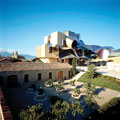
Photo courtesy of Herederos del Marqués de Riscal
Constructed of local sandstone and titanium, the Marqués de Riscal Hotel - designed by internationally acclaimed architect Frank O. Gehry - has become a signature building on the Herederos del Marqués de Riscal estate, which sits in the heart of the Rioja Alavesa region in the medieval village of Elciego, Spain. Design Architect: Frank O. Gehry; Consulting Architect: IDOM, Bilbao, Spain; Stone Supplier: Areniscas Stone, Burgos, Spain (Beige Pinar sandstone)
Constructed of local sandstone and titanium, the Marqués de Riscal Hotel - designed by internationally acclaimed architect Frank O. Gehry - has become a signature building on the Herederos del Marqués de Riscal estate, which sits in the heart of the Rioja Alavesa region in the medieval village of Elciego, Spain. Design Architect: Frank O. Gehry; Consulting Architect: IDOM, Bilbao, Spain; Stone Supplier: Areniscas Stone, Burgos, Spain (Beige Pinar sandstone)
Nestled in Spain’s northeast quadrant is La Rioja - the country’s smallest region. The area derives its name from Río (meaning “river” in Spanish) Oja, a tributary of the River Ebro, Spain’s longest river. And while relatively small in size, La Rioja is one of Spain’s most notable regions, as it is home to more than 500 wineries - many which are recognized worldwide. In particular, Herederos del Marqués de Riscal has drawn much attention for its recent $100 million renovation project that included the addition of a luxury hotel on its 24-acre estate, which was the creation of renowned architect Frank O. Gehry.

While the use of local sandstone for the structure’s exterior facade anchors it in the soil, its curvature titanium roof provides a modern look.

Photo by Jennifer Adams
“For this project, Gehry has used materials and forms similar to those used in the Bilbao Guggenheim Museum, but this time, the titanium which covers the structure - the Canadian architect’s trademark - are in the color of Marqués de Riscal,” according to a statement released by the winery. “Pink for the red wine, gold for the mesh which covers the bottle and silver for the capsule of the bottle.”
“For this project, Gehry has used materials and forms similar to those used in the Bilbao Guggenheim Museum, but this time, the titanium which covers the structure - the Canadian architect’s trademark - are in the color of Marqués de Riscal,” according to a statement released by the winery. “Pink for the red wine, gold for the mesh which covers the bottle and silver for the capsule of the bottle.”
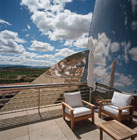
Photo courtesy of Herederos del Marqués de Riscal
In addition to the hotel’s exterior skin, the beige-colored local sandstone was used for additional applications such as flooring on the attached terraces.
In addition to the hotel’s exterior skin, the beige-colored local sandstone was used for additional applications such as flooring on the attached terraces.
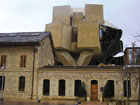
The reason for the prevalent use of stone for the 43-room hotel is attributed to the estate’s pre-existing traditional-style architecture, which also extensively features the local sandstone. The building appears to rest on large sandstone “piers,” further anchoring it to the landscape.
Photo by Jennifer Adams
Photo by Jennifer Adams
Upon entering the grounds, the new hotel, which consists of two wings connected by a suspended footbridge, presents a strong visual. The design intent for the building was to make it appear as if it is rising from the ground. While the use of sandstone for the structure’s exterior facade connects it to the earth, its curved titanium roof against the picturesque Basque countryside forms a striking contrast to the historic stone buildings.
The sandstone selected is named Beige Pinar (Pinewood Beige), and it was quarried approximately an hour from the hotel site. The prevalent use of the local stone, which was supplied by Areniscas Stone of Burgos, Spain, for the 43-room hotel is a tribute to the estate’s pre-existing, traditional-style architecture, which extensively features the local sandstone. According to Areniscas Stone, the Beige Pinar variety is a siliceous sandstone with a high level of quartz (96%) in its composition.
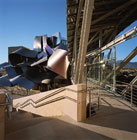
The hotel consists of two wings connected by a suspended footbridge, and stone was also used for this area.
Photo courtesy of Herederos del Marqués de Riscal
Photo courtesy of Herederos del Marqués de Riscal
Additionally, almost 6,000 square feet of the sandstone in approximate 31- x 24- x 2-inch pieces was utilized as paving for the terraces. The sandstone was also used to form architectural elements such as planters. The building appears to rest on large sandstone “piers,” further anchoring it to the landscape.

Gehry’s signature design for the Marqués de Riscal hotel creates a striking contrast against the picturesque Basque countryside, although the building’s sandstone cladding remains connected to the natural stone outcrops along the landscape.
Photo courtesy of Herederos del Marqués de Riscal
Photo courtesy of Herederos del Marqués de Riscal
In stark contrast to the traditional stone materials, nearly 20,000 square feet of titanium was imported from Japan and used for the roof of the building. The titanium and forms implemented in the structure’s design are said to be reminiscent of Gehry’s design of the Guggenheim Museum in Bilbao, Spain, which he created in 1997. Hailed by many as one of the most significant structures of its time, the museum is comprised of titanium, limestone and glass.
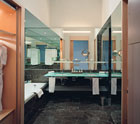
An elegant aesthetic was achieved in the hotel’s guest room baths with Nero Marquina marble, quarried in Spain.
Photo courtesy of Herederos del Marqués de Riscal
Photo courtesy of Herederos del Marqués de Riscal
Gehry presented the model of the City of Wine on June 1, 2000, in the old wine cellars on Marqués de Riscal’s estate. “From that moment, the project generated wide interest nationally and internationally, as it is not only strong backing for the ‘World of Wine,’ but also architecturally significant, as Gehry has employed a new, more advanced architectural language than that he used for the Bilbao Guggenheim Museum,” stated Marqués de Riscal, adding that the model was included in the exhibition held by the New York Metropolitan Museum of Art (MOMA) in May 2006 under the title “New Spanish Architecture.”

In addition to the exterior applications, the local sandstone punctuates certain areas of the interior architecture, such as in the wine bar. A backlit onyx countertop further contributes to the chic atmosphere of the establishment.
Photo courtesy of Herederos del Marqués de Riscal
Photo courtesy of Herederos del Marqués de Riscal
Opening ceremonies of Herederos del Marqués de Riscal’s “City of Wine” were held on October 10, 2006. His Majesty Juan Carlos de Borbón of Spain presided over the event. Local officials welcomed the King of Spain at the Plaza del Reloj - the point where the winery’s three cellars - built in 1858, 1883 and 2006 - connect. He was led through the winery’s original cellar, which is located directly underneath the Marqués de Riscal Hotel, to see the Royal Vintage of his father, Don Juan de Borbon, and the new barrels reserved in his name. The tour continued with a stop at the renowned Cathedral of Wine - the historic dusky cellar that holds approximately 180,000 wine bottles from the very first vintage onward. The King personally chose and tasted a 1938 bottle from his year of birth. After the tour of the winery, Gehry and his design team presented the King with their design plan and details of construction for the hotel.
A total of 1,400 people were in attendance as winery officials presented the King with a commemorative plaque, and the “City of Wine” was officially inaugurated. The King was then treated to a private reception where the exclusive 2001 Frank Gehry Selection Wine - produced from 100% Tempranillo vines over 40 years old - was unveiled. The wine, produced in commemoration of the opening, has an allocation of only 5,000 bottles that will only be available in Spain, according to Marqués de Riscal.
“To sum up, this project is the result of the union between the best Rioja wine tradition and modernity - all of which make this a unique place - where three centuries of history are brought together for wine tourism lovers,” according to a statement made by the winery.

Photos by Jennifer Adams
Marqués de Riscal of Elciego, Spain, started its winemaking business in 1858. The buildings on its estate were designed by Spanish architect Ricardo Bellsola, who modeled the wine cellars after the finest in the Bordeaux region of France.
Marqués de Riscal of Elciego, Spain, started its winemaking business in 1858. The buildings on its estate were designed by Spanish architect Ricardo Bellsola, who modeled the wine cellars after the finest in the Bordeaux region of France.
Sidebar: Remaining true to its origins
Herederos del Marqués de Riscal - recognized worldwide for its savory selection of wine - is a company rich in tradition and history. Founded in 1858, the estate is situated in the heart of the Rioja Alavesa region in the medieval village of Elciego, Spain. Today, the Marqués de Riscal brand can be found in 70 countries, with the U.S. being its largest importer.The winery originated when Camilo Hurtado de Amézaga, a Spanish diplomat and journalist who owned vineyards and a bodega on the Torrea estate in Elciego and resided in Bordeaux, France, since 1836, was approached by the Diputación Foral de Alava to bring a French winemaker to the region to share the techniques of the French winemaking system. The hope was to bring growth to the Rioja Alavesa region.

The buildings at Marqués de Riscal are all made of local cut sandstone, which was also used for the exterior of the winery’s most recent addition - a high-end hotel designed by Frank O. Gehry.
Remaining optimistic, Marqués de Riscal saw this as an opportunity and hired Pineau in 1860 - the same year its first wine cellar had been built. With Pineau now on staff, however, it was decided to further expand the facilities. Ricardo Bellsola was contracted to build the new cellars. The architect traveled to Bordeaux to study the most prestigious wine cellars so that he could use this knowledge in the design of Marqués de Riscal’s new facilities.
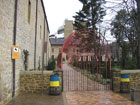
The first wine cellar on the 24-acre estate was completed in 1860. While existing facilities were enlarged in 1883, further expansions did not come again until 1968 and 2000.
While the Marqúes de Riscal complex has experienced expansion through the decades, the winery believes that it has stayed true to its origins. And when walking the grounds, it is apparent that this is true. Due to the increase in wine production, the cellars were enlarged in 1883 and then not again until 1968 and 2000. The architecture of the various structures on the estate remains consistent - all built of local sandstone. Even the latest addition to the grounds - a luxury hotel built by renowned architect Frank O. Gehry - utilizes the same local stone in its design, although it features a modern twist.
Appreciated around the world for its fine wines, Marqués de Riscal continually strives to improve upon its success - both in its production and presentation. The winery currently produces approximately 3.75 million bottles of its white wines and 1 million bottles of Tinto Riscal red wine each year.